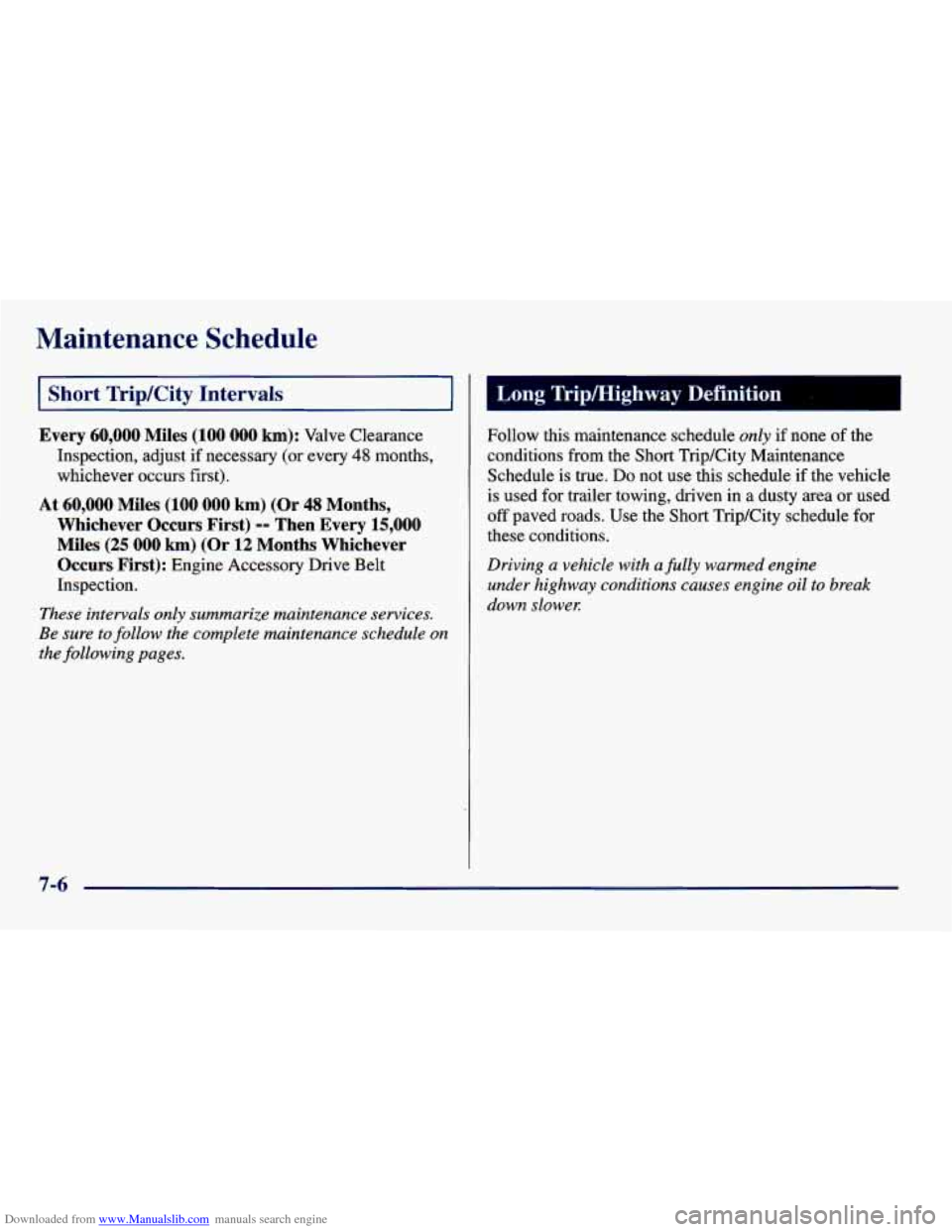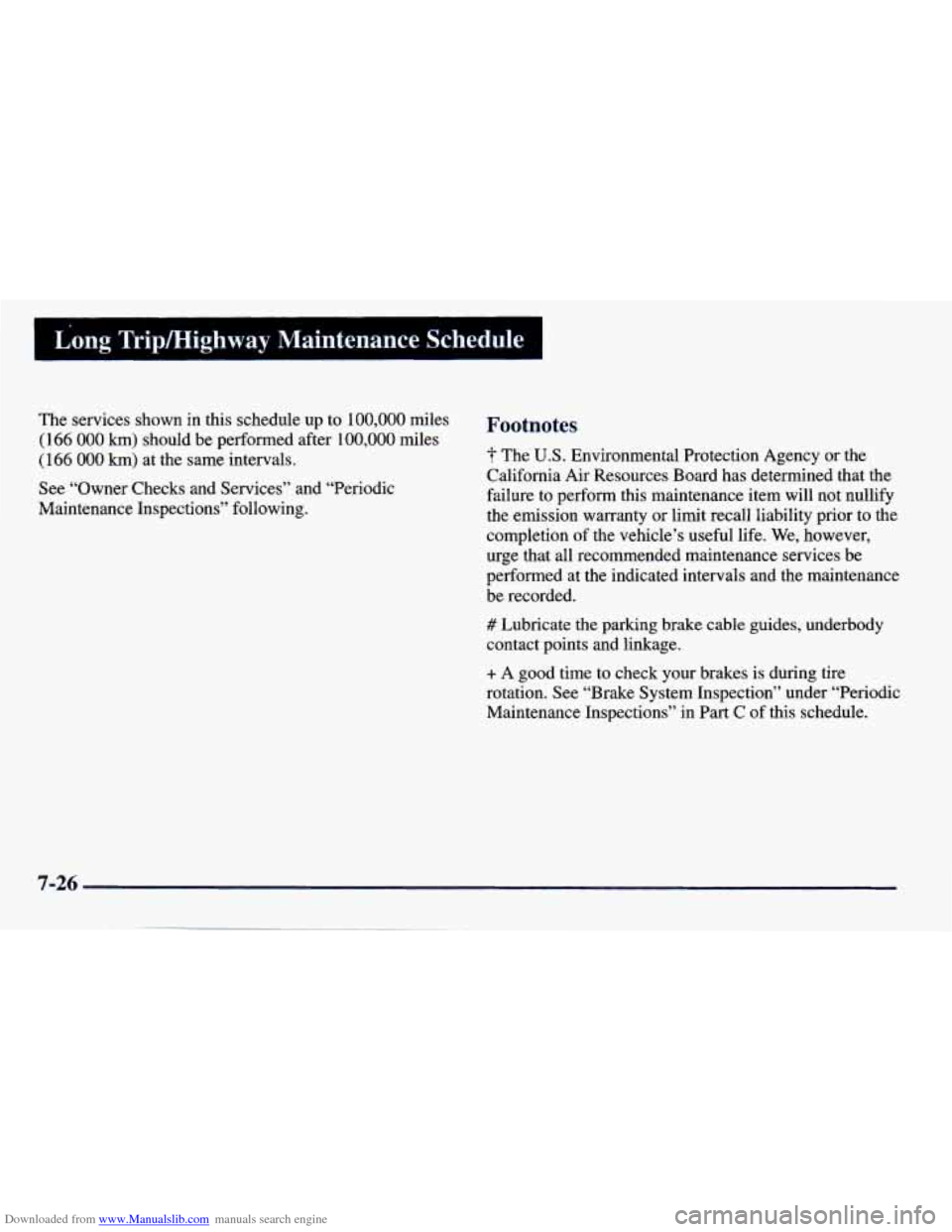1998 CHEVROLET PRIZM service interval
[x] Cancel search: service intervalPage 265 of 364

Downloaded from www.Manualslib.com manuals search engine Tire Inspection and Rotation
Tires should be rotated every 6,000 to 8,000 miles
(10 000 to 13 000 km). Any time you notice unusual
wear, rotate your tires as soon as possible and check
wheel alignment. Also check for damaged tires or
wheels. See “When It’s Time for New Tires” and
“Wheel Replacement” later in this section for
more information.
The purpose of regular rotation is to achieve more
uniform wear for all tires on the vehicle. The first
rotation is the most important. See “Scheduled
Maintenance Services” in the Index for scheduled
rotation intervals. Don’t include the compact spare tire
in your
tire rotation.
After the tires have been rotated, adjust the front
and rear inflation pressures as shown on the
Tire-Loading Information label. Make certain that
all wheel nuts are properly tightened. See “Wheel
Nut Torque” in the Index.
When rotating your tires, always
use the correct rotation
pattern shown here.
-
A CA u T1GI.C:
Rust or dirt on a wheel, or on the parts to which
it is fastened, can make wheel nuts become loose
after
a time. The wheel could come off and cause
an accident. When you change
a wheel, remove
any rust or dirt from places where the wheel
attaches to the vehicle. In an emergency, you can
use
a cloth or a paper towel to do this; but be
sure to use a scraper or wire brush later, if you
need to, to get all the rust or
dirt off. (See
“Changing
a Flat Tire” in the Index.)
I
6-39
Page 287 of 364

Downloaded from www.Manualslib.com manuals search engine 0 Section 7 Maintenance Schedule
This section covers the maintenance required for your vehicle. Your vehicle needs these services to retain its \
safety,
dependability and emission control performance.
7-2
7 -4
7-5
7-5
7-5
7-6
7-7
Short TripKity Maintenance Schedule
Long Triphlighway Maintenance Schedule
Part
B: Owner Checks and Services
Part C: Periodic Maintenance Inspections
Part D: Recommended Fluids and Lubricants
Part
E: Maintenance Record
Introduction
Part
A: Scheduled Maintenance Services
Maintenance Schedule
Short Trip/City Definition
Short TripKity Intervals
Long Tripmighway Definition
Long Tripmighway Intervals
7-8
7-26
7-37 7-42
7-44
7-46
7-1
Page 291 of 364

Downloaded from www.Manualslib.com manuals search engine Maintenance Schedule
I Short Trip/City Definition I
Follow the Short TripKity Maintenance Schedule if any
one of these conditions is true for your vehicle:
0
0
0
0
0
Most trips are less than 5 to 10 miles (8 to 16 km).
This is particularly important when outside
temperatures are below freezing.
Most trips include extensive idling (such as frequent
driving in stop-and-go traffic).
Most trips are through dusty areas. You frequently tow a trailer or use
a carrier on top of
your vehicle.
If the vehicle is used for delivery service, police, taxi
or other commercial application.
One of the reasons you should follow this schedule
if you operate your vehicle under any of these conditions
is that these conditions cause engine oil to break
down soonez
Short Trip/City Intervals
Every 3,000 Miles (5 000 km): Engine Oil and Filter
Change (or
3 months, whichever occurs first).
Every 6,000 Miles (10 000 km): Chassis Lubrication
(or
6 months, whichever occurs first). Tire
Rotation. Air Cleaner Filter Inspection,
if driving
in dusty conditions.
Every 15,000 Miles (25 000 km): Automatic Transaxle
Fluid Change (severe conditions only). Automatic
Transaxle Fluid Check (normal conditions).
Every 30,000 Miles (50 000 km): Air Cleaner Filter
Replacement. Spark Plug Replacement. Fuel Tank,
Cap, Cap Gasket and Lines Inspection (or every
24 months, whichever occurs first). Manual Transaxle
Fluid Change (severe conditions only) (or every
24 months, whichever occurs first). Cooling System
Service (or every
24 months, whichever occurs first).
(Continued)
7 -5
Page 292 of 364

Downloaded from www.Manualslib.com manuals search engine Maintenance Schedule
I Short TripKity Intervals I
Every 60,000 Miles (100 000 km): Valve Clearance
Inspection, adjust if necessary
(or every 48 months,
whichever occurs first).
Whichever Occurs First) -- Then Every 15,000
Miles (25 000 km) (Or 12 Months Whichever
Occurs First):
Engine Accessory Drive Belt
Inspection.
At 60,000 Miles (100 000 km) (Or 48 Months,
These intervals only summarize maintenance services.
Be sure to follow the complete maintenance schedule
on
the following pages.
Follow this maintenance schedule only if none of the
conditions from the Short Trip/City Maintenance
Schedule is true.
Do not use this schedule if the vehicle
is used for trailer towing, driven in a dusty area
or used
off paved roads. Use the Short Trip/City schedule for
these conditions.
Driving a vehicle with a fully warned engine
under highway conditions causes engine oil to break
down slower:
Page 293 of 364

Downloaded from www.Manualslib.com manuals search engine Maintenance Schedule
Change (or every 12 months, whichever occurs first).
Chassis Lubrication (or every 12 months, whichever
occurs first). Tire Rotation.
Every 15,000 Miles (25 000 km): Automatic Transaxle
Fluid Change (severe conditions only). Automatic
Transaxle Fluid Check (normal conditions).
Every 30,000 Miles (50 000 km): Spark Plug
Replacement. Air Cleaner Filter Replacement. Fuel
Tank, Cap, Cap Gasket and Lines Inspection (or every
24 months, whichever occurs first). Manual Transaxle
Fluid Change (severe conditions only) (or every 24 months, whichever occurs first). Cooling System
Service (or every 24 months, whichever occurs first).
'Long Tripmighway Intervals
Every 60,000 Mile 00 000 km): Valve Clearance
Inspection, adjust
if necessary (or every 48 months,
whichever occurs first).
At 60,000 Miles (100 000 km) (or 48 Months,
Whichever Occurs First)
-- Then Every 15,000 Miles
(25 000 km) (or 12 Months, Whichever Occurs
First):
Engine Accessory Drive Belt Inspection.
These intervals only summarize maintenance services.
Be sure to follow the complete maintenance schedule
on the following pages.
Page 294 of 364

Downloaded from www.Manualslib.com manuals search engine I Short TripKity Maintenance Schedule I
The services shown in this schedule up to 100,000 miles
(166 000 km) should be performed after 100,000 miles
(166 000 km) at the same intervals.
See “Owner Checks and Services” and “Periodic
Maintenance Inspections” following.
Footnotes
-f The U.S. Environmental Protection Agency or the
California Air Resources Board has determined that the
failure to perform this maintenance item will not nullify
the emission warranty or limit recall liability prior to the
completion of the vehicle’s useful life. We, however,
urge
that all recommended maintenance services be
performed at the indicated intervals and the maintenance
be recorded.
# Lubricate the parking brake cable guides, underbody
contact points and linkage.
+ A good time to check your brakes is during tire
rotation. See “Brake System Inspection” under “Periodic
Maintenance Inspections” in Part
C of this schedule.
7-8
Page 312 of 364

Downloaded from www.Manualslib.com manuals search engine Long Tripmighway P“aintenance Schedule
The services shown in this schedule up to 100,000 miles
(166
000 km) should be performed after 100,000 miles
(166 000 km) at the same intervals.
See “Owner Checks and Services” and “Periodic
Maintenance Inspections” following.
Footnotes
The U.S. Environmental Protection Agency or the
California Air Resources Board has determined that the
failure to perform this maintenance item will not nullify the emission warranty
or limit recall liability prior to the
completion
of the vehicle’s useful life. We, however,
urge that all recommended maintenance services be
performed at the indicated intervals and the maintenance
be recorded.
# Lubricate the parking brake cable guides, underbody
contact points and linkage.
+ A good time to check your brakes is during tire
rotation. See “Brake System Inspection” under “Periodic
Maintenance Inspections’’ in Part
C of this schedule.
7-26
Page 323 of 364

Downloaded from www.Manualslib.com manuals search engine Part B: Owner Checks and Services
Listed below are owner checks and services which
should be performed at
the intervals specified to help
ensure the safety, dependability and emission control
performance of your vehicle.
Be sure any necessary repairs are completed at once.
Whenever any fluids or lubricants are added to your vehicle, make sure they are the proper ones, as shown
in Part
D.
At Each Fuel Fill
It is important for you or a service station attendant to
perjimn these underhood checks at each fuel fill.
Engine Oil Level Check
Check the engine oil level and add the proper oil
if necessary. See “Engine
Oil” in the Index for
further details.
Engine Coolant Level Check
Check the engine coolant level and add the proper
coolant mixture if necessary. See “Engine Coolant”
in
the Index for further details.
Windshield Washer Fluid Level Check
Check the windshield washer fluid level in the
windshield washer
tank and add the proper fluid if
necessary. See “Windshield Washer Fluid” in the
Index for further details.
Hood Latch Operation Check
Pull the primary hood latch release handle inside the
vehicle. The secondary latch should keep the hood from opening all the way when
the primary latch is released.
Make sure
the hood closes firmly. See “Hood Release”
in the Index for further details.
At Least Once a Month
Tire Inflation Check
Make sure tires are inflated to the correct pressures.
See “Tires”
in the Index for further details.
Cassette Deck Service
Clean cassette deck. Cleaning should be done every
50 hours of tape play. See “Audio Systems” in the
Index for further details.
7-37